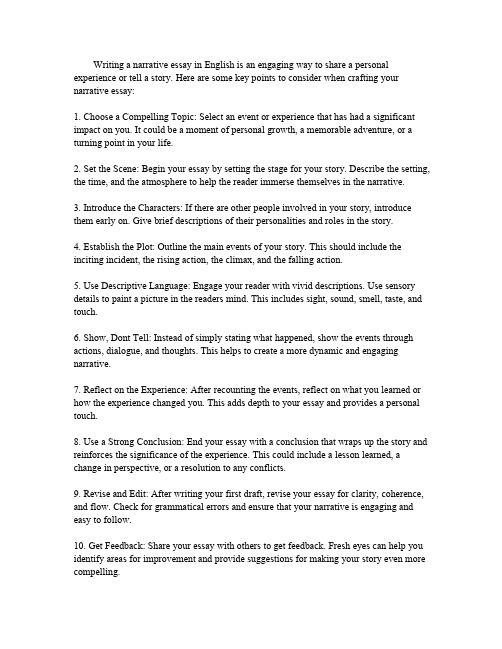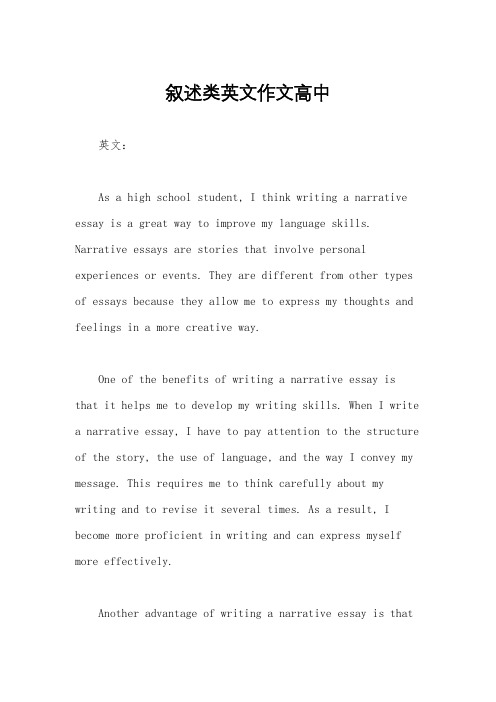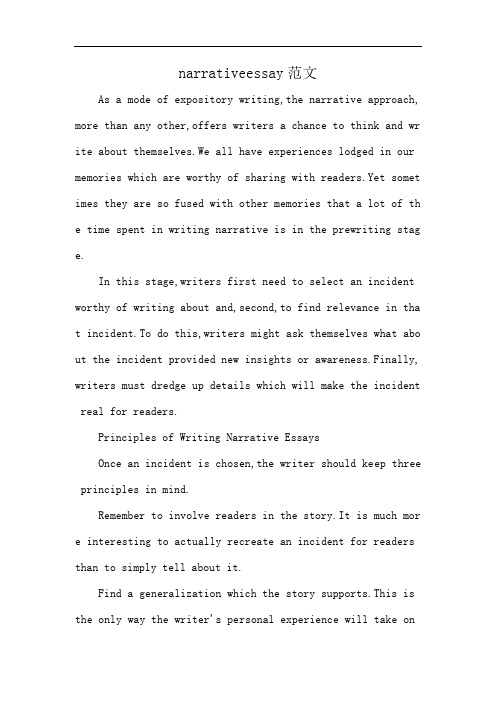高级英语写作NarrativeWritingejm
关于写事的作文英语作文

Writing a narrative essay in English is an engaging way to share a personal experience or tell a story.Here are some key points to consider when crafting your narrative essay:1.Choose a Compelling Topic:Select an event or experience that has had a significant impact on you.It could be a moment of personal growth,a memorable adventure,or a turning point in your life.2.Set the Scene:Begin your essay by setting the stage for your story.Describe the setting, the time,and the atmosphere to help the reader immerse themselves in the narrative.3.Introduce the Characters:If there are other people involved in your story,introduce them early on.Give brief descriptions of their personalities and roles in the story.4.Establish the Plot:Outline the main events of your story.This should include the inciting incident,the rising action,the climax,and the falling action.e Descriptive Language:Engage your reader with vivid e sensory details to paint a picture in the readers mind.This includes sight,sound,smell,taste,and touch.6.Show,Dont Tell:Instead of simply stating what happened,show the events through actions,dialogue,and thoughts.This helps to create a more dynamic and engaging narrative.7.Reflect on the Experience:After recounting the events,reflect on what you learned or how the experience changed you.This adds depth to your essay and provides a personal touch.e a Strong Conclusion:End your essay with a conclusion that wraps up the story and reinforces the significance of the experience.This could include a lesson learned,a change in perspective,or a resolution to any conflicts.9.Revise and Edit:After writing your first draft,revise your essay for clarity,coherence, and flow.Check for grammatical errors and ensure that your narrative is engaging and easy to follow.10.Get Feedback:Share your essay with others to get feedback.Fresh eyes can help you identify areas for improvement and provide suggestions for making your story even more compelling.Remember,the goal of a narrative essay is to tell a story that is both engaging and meaningful.By following these guidelines,you can create an essay that not only tells a story but also leaves a lasting impression on your reader.。
五种不同文体的英语作文

五种不同文体的英语作文1. Narrative:I woke up to the sound of birds chirping outside my window. The sun was shining brightly, and I could feel the warmth of its rays on my face. I decided to go for a walk in the park, and as I strolled along the path, I couldn't help but admire the beauty of nature surrounding me.2. Descriptive:The aroma of freshly baked cookies filled the air as I entered the kitchen. The cookies were golden brown and perfectly crispy on the edges, with gooey chocolate chips melting in the center. I took a bite and savored the rich, buttery flavor that melted in my mouth.3. Persuasive:It's time to take action and make a difference in ourcommunity. Whether it's volunteering at a local shelter, organizing a fundraiser, or simply spreading awareness about important issues, each and every one of us has the power to create positive change. Let's come together and work towards a better future for all.4. Expository:The process of photosynthesis is crucial for the survival of all living organisms on Earth. Through this complex biochemical reaction, plants are able to convert sunlight, water, and carbon dioxide into energy-rich molecules that fuel their growth and development. Without photosynthesis, the entire food chain would collapse, leading to catastrophic consequences for the planet.5. Reflective:Looking back on my childhood, I can't help but feel grateful for the experiences that shaped me into the person I am today. From the simple joys of playing in the backyard to the challenges of navigating adolescence, each momenthas contributed to my growth and resilience. It's a reminder that every obstacle we face has the potential to become a stepping stone towards personal development.。
叙述类英文作文高中

叙述类英文作文高中英文:As a high school student, I think writing a narrative essay is a great way to improve my language skills. Narrative essays are stories that involve personal experiences or events. They are different from other types of essays because they allow me to express my thoughts and feelings in a more creative way.One of the benefits of writing a narrative essay isthat it helps me to develop my writing skills. When I write a narrative essay, I have to pay attention to the structure of the story, the use of language, and the way I convey my message. This requires me to think carefully about my writing and to revise it several times. As a result, I become more proficient in writing and can express myself more effectively.Another advantage of writing a narrative essay is thatit allows me to reflect on my experiences. When I write about something that happened to me, I have to think about how it affected me and what I learned from it. This helps me to gain a deeper understanding of myself and the world around me. In addition, it allows me to share myexperiences with others and to connect with them on adeeper level.Overall, writing a narrative essay is a great way to improve my language skills and to reflect on my experiences. By practicing my writing and expressing myself in acreative way, I can become a more effective communicatorand a better writer.中文:作为一名高中生,我认为写叙述性文章是提高语言能力的好方法。
英语作文记叙

英语作文记叙Narrative Writing: A Captivating Journey。
Narrative writing is a powerful form of expression that allows us to share our experiences, emotions, and perspectives with others. Through the art of storytelling, we can transport readers to different worlds, immerse them in compelling narratives, and leave a lasting impact on their minds. In this essay, I will delve into the essence of narrative writing, exploring its key elements, the process of crafting an engaging story, and the profound impact it can have on both the writer and the reader.At the heart of narrative writing lies the art of weaving a captivating tale. Whether it's a personal anecdote, a fictional account, or a historical narrative, the writer's primary task is to captivate the reader's attention and guide them through a meaningful journey. This journey is often characterized by a series of events, characters, and conflicts that unfold in a logical andengaging manner.One of the fundamental elements of narrative writing is the development of characters. Readers are drawn to stories that feature well-developed, relatable, and complex characters who undergo transformations and face challenges throughout the narrative. The writer must carefully craft the characters' personalities, motivations, and arcs, ensuring that they feel authentic and compelling to the reader.Another crucial aspect of narrative writing is the use of vivid and descriptive language. The writer must paint a vivid picture in the reader's mind, utilizing sensory details, evocative imagery, and precise word choices to immerse the reader in the story's setting and atmosphere. This attention to detail not only enhances the reader's experience but also helps to establish the tone and mood of the narrative.The structure of a narrative is also a key consideration for the writer. Effective narratives oftenfollow a traditional plot structure, which includes an exposition, rising action, climax, falling action, and resolution. This structure helps to create a sense of tension, suspense, and narrative arc, guiding the reader through the story's progression and ensuring a satisfying conclusion.In addition to the technical aspects of narrative writing, the writer must also consider the emotional impact of their work. Successful narratives have the power to evoke a range of emotions in the reader, from joy and laughter to sorrow and contemplation. By tapping into the reader's empathy and connecting with their own experiences and emotions, the writer can create a profound and lasting impression.The process of crafting a compelling narrative is not without its challenges. Writers must navigate the delicate balance between creativity and structure, between authenticity and artistic license. They must be willing to revise and refine their work, constantly striving to improve and refine their craft.Despite these challenges, the rewards of narrative writing are immense. When a writer succeeds in creating a captivating story that resonates with readers, they have the power to transport, inspire, and transform. Narrative writing has the ability to foster empathy, promote understanding, and shed light on the human experience inall its complexity.In conclusion, narrative writing is a powerful and versatile form of expression that allows writers to share their stories, perspectives, and emotions with the world. By mastering the art of storytelling, writers can create works that captivate, enlighten, and leave a lasting impression on their readers. Whether you are a seasoned writer or just beginning your journey, the art of narrative writing offers endless possibilities for self-expression, exploration, and connection.。
叙事英文作文写作技巧

叙事英文作文写作技巧Narrative Writing Techniques。
Narrative writing is a type of writing that tells a story. It can be fiction or non-fiction, and it can be written in a variety of styles. Narrative writing is a powerful tool for writers because it allows them to create a world that the reader can enter and experience. Here are some techniques that writers use to create compelling narratives.1. Characterization。
The characters in a narrative are the driving force behind the story. They are the ones who make the choices and take the actions that move the plot forward. Good characterization is essential for a compelling narrative. The writer must create characters that are believable, relatable, and interesting. The reader must care about what happens to the characters and be invested in their journey.2. Setting。
The setting of a narrative is the world in which the story takes place. It can be a real place or a fictional one. The setting can be used to create mood, atmosphere,and tension. The writer must describe the setting in a way that allows the reader to visualize it and feel like they are there.3. Plot。
高级英文叙事作文模板

高级英文叙事作文模板英文:Narrative writing is a style of writing that tells a story. It can be fiction or non-fiction, and it can be written in first, second, or third person. When writing a narrative, it's important to have a clear beginning, middle, and end. This helps to create a sense of structure and allows the reader to follow the story easily.One common structure for a narrative is to introducethe characters and setting in the beginning, then present a problem or conflict in the middle, and finally resolve the conflict in the end. This structure creates a sense of tension and keeps the reader engaged.Another important aspect of narrative writing is theuse of descriptive language. This helps to create a vivid picture in the reader's mind and makes the story more engaging. For example, instead of saying "the car was red,"you could say "the bright, cherry red sports car gleamed in the sunlight."In addition, dialogue can be used to bring the characters to life and make the story more realistic. It's important to use dialogue that is natural and fits the character's personality.中文:叙事写作是一种讲述故事的写作方式。
narrativeessay范文

narrativeessay范文As a mode of expository writing,the narrative approach, more than any other,offers writers a chance to think and wr ite about themselves.We all have experiences lodged in our memories which are worthy of sharing with readers.Yet somet imes they are so fused with other memories that a lot of th e time spent in writing narrative is in the prewriting stag e.In this stage,writers first need to select an incident worthy of writing about and,second,to find relevance in tha t incident.To do this,writers might ask themselves what abo ut the incident provided new insights or awareness.Finally, writers must dredge up details which will make the incident real for readers.Principles of Writing Narrative EssaysOnce an incident is chosen,the writer should keep three principles in mind.Remember to involve readers in the story.It is much mor e interesting to actually recreate an incident for readers than to simply tell about it.Find a generalization which the story supports.This is the only way the writer's personal experience will take onmeaning for readers.This generalization does not have to en compass humanity as a whole;it can concern the writer,men,w omen,or children of various ages and backgrounds.Remember that although the main component of a narrativ e is the story,details must be carefully selected to suppor t,explain,and enhance the story.Conventions of Narrative EssaysIn writing your narrative essay,keep the following conv entions in mind.Narratives are generally written in the first person,th at is,using"I."However,third person("he,""she,"or"it")can a lso be used.Narratives rely on concrete,sensory details to convey t heir point.These details should create a unified,forceful e ffect,a dominant impression.More information on sensory det ails is available.Narratives,as stories,should include these story conven tions:a plot,including setting and characters;a climax;and an ending.。
叙述文作文模板英语版

叙述文作文模板英语版Narrative Essay Writing Template。
Introduction。
Begin with a captivating hook that grabs the reader's attention.Provide necessary background information to establish the context of the essay.State your thesis statement, which is the main point you will argue or explore in your essay.Body Paragraph 1。
Provide details and evidence to support the first point related to your thesis statement.Use vivid language, sensory imagery, and specificexamples to make the narrative compelling.Transition smoothly to the next paragraph.Body Paragraph 2。
Move to the next point or aspect of your thesis statement.Continue to develop your argument or narrative with specific examples and evidence.Explain the significance of the events or details you are describing.Body Paragraph 3 (Optional)。
Include additional details or perspectives that strengthen your thesis statement.This paragraph can provide further context, analysis, or reflection on the narrative.Use vivid language and specific examples to keep the reader engaged.Body Paragraph 4。
- 1、下载文档前请自行甄别文档内容的完整性,平台不提供额外的编辑、内容补充、找答案等附加服务。
- 2、"仅部分预览"的文档,不可在线预览部分如存在完整性等问题,可反馈申请退款(可完整预览的文档不适用该条件!)。
- 3、如文档侵犯您的权益,请联系客服反馈,我们会尽快为您处理(人工客服工作时间:9:00-18:30)。
• The who, what, where, when, why, and how outline that gives the narrative direction.
• What is the story about? • Events unfold as they happen. • The frame of the narrative.
Elements of Narrative Writing
CHARACTERS
•The people, animals, or inanimate objects who are affected by the actions of the plot or who are the cause of certain events.
author, he/she must create a picture for the readers.
Elements of Narrative Writing
STYLE
• The figurative language (similes, metaphors, etc.), sensory imagery, vivid verbs, strong sentences, dialogue, and point of view that makes each author unique.
Plot Structure of Narrative Writing
• Beginning: – Enticing opening to capture readers’ interest. – Setting revealed. – Main characters introduced. – Conflict presented.
Plot Structure of Narrative Writing
• Middle – Characters attempt to resolve conflicts or problems. – Action progresses sequentially, step by step.
• Climax – The turning point of the narrative. – Reveals the process involved for solving the conflicts.
characters. – Reader must guess the feelings of the characters by
their actions and words. – Example: He pounded his fist against the wall and
screamed, “Let me out!”
Types of Conflict: Examples
Person versus Society: Abby needs to go to the library to begin working on
her project. When she arrives, she finds out that juveniles under the age of eighteen cannot enter the library without a parent. Her mom is at work. Abby is mad about this thing, totally out of her
Different Points of View
• Third Person point of view Omniscient
– “He,” “she,” “it,” “they” perspective – Narrator can write about the thoughts and feelings of
shambles.
Elements of Narrative Writing
THEME
• A theme is a message revealed in the story. • It may be directly stated, like in a fable where the
moral is told at the conclusion. • It may be indirect, leaving the reader to decide
Elements of Narrative Writing
SETTING
• Where and when the narrative takes place. • Allows the readers to visualize the scenes
and the characters in those scenes. • Although the setting may be clear for the
• This type of writing makes the reader feel as if her or she were part of the story, as if it was being told directly to him or her.
Elements of Narrative Writing
Types of Conflict: Examples
Person versus Self: One month ago, Abby was assigned a book to read
for a book report. Upon sitting at the computer to work on it, Abby struggled with the decision to do the reading or to surf the web instead. She felt guilty, knowing she should do the work, but
all the characters. – Example: “She called hielling the truth.”
5 W+H Questions Method
• Answering the 5 W and H questions provides the basic info needed to begin a story.
Narrative Writing
What is Narrative Writing?
• A narrative is a story containing specific elements that work together to create interest for not only the author but also the reader.
• The problem that must be overcome or resolved so that the readers will not be left hanging.
• Types of Conflict:
– Person versus Self – Person versus Person – Person versus Society – Person versus Machine/Technology – Person versus Nature
• Every student has his/her own style and technique. Although we have the same topic, everyone will write differently.
Elements of Narrative Writing
CONFLICT
died…
Different Points of View
• Third Person point of view Limited
– “He,” “she,” “it,” “they” perspective – Written as if the story is observed from outside of the
Plot Structure of Narrative Writing
• End – Tells how the resolution of the conflicts have affected the characters. – No new characters or plot ideas introduced. – Theme or message understood by reader.
•Characters, real or imaginative, should be brought to life through the narrative.
•If a character is not described well, the story will not be believable.
the story’s message. • There can be more than one theme for a
narrative.
Different Points of View
Who is telling the story?
• First Person point of view
– “I” as the narrator – Good for personal accounts. – Example: I will never forget the day that my hamster
was really motivated by her desire to look up new information about her favorite rock band.
